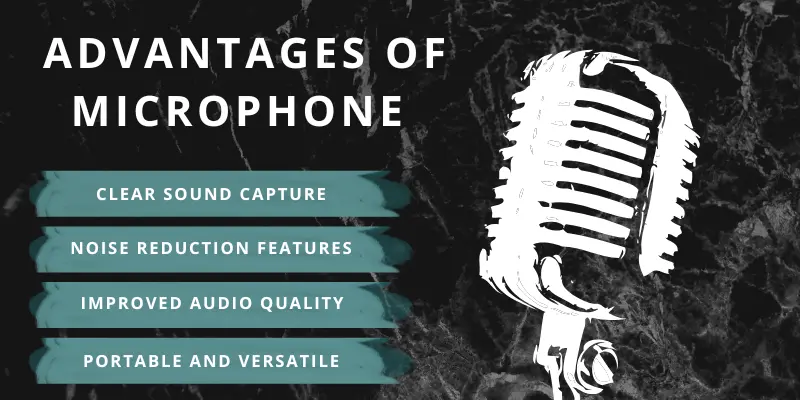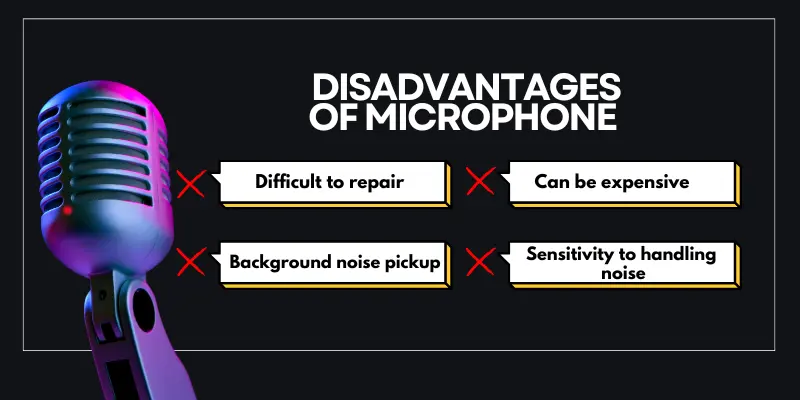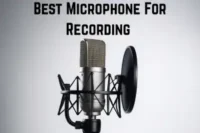10 Advantages and Disadvantages of Microphones: How to Choose the Best Mic for You
Published: July 31, 2025
Microphones have transformed how we communicate, record, and perform. They pick up sound and convert it into electrical signals that can be heard or recorded. However, as with any tool, microphones have advantages and disadvantages that influence how well they work. Knowing the advantages and disadvantages of microphones can help you choose the best one for your needs.
What is a Microphone?
A microphone is a device that records audio. It converts the sounds you speak, perform, and play into electrical signals. These signals can then be recorded, amplified, or transmitted via speakers. You use microphones in a variety of settings, including your phone, concerts, and video calls. Simply put, a microphone allows your voice or music to be heard clearly.

Advantages of a Microphone
Microphones have many advantages in how we communicate and create sound. They help with recording clear audio for a variety of applications. Here are the main advantages of using a microphone:
|
1. Clear sound capture
Microphones pick up sound very well. They catch your voice or instruments. This helps others hear you without any fuzz or noise. Good microphones make your audio sharp and easy to understand. This is important for calls, recordings, and performances.
2. Improved audio quality
A microphone makes sound better than just a phone or computer mic. It reduces background noise and focuses on the main sound. This means your voice or music sounds clean and smooth. Better audio quality makes listening more enjoyable. It also helps in professional recordings.
3. Hands-free communication
Some microphones allow you to talk without holding them. For example, clip-on or headset microphones allow you to move freely. This is ideal for singers, presenters, or those who work while talking. Hands-free microphones make tasks easier and more comfortable. You can concentrate on your task without worrying about the microphone.
4. Noise reduction features
Many microphones include technology to block out noises that are not needed. This silences background noise such as fans, traffic, or other voices. It helps your voice sound clearer. Noise reduction is ideal for noisy environments or online meetings. It makes your audio clearer and less distracting.
5. Easy to use
Most microphones are simple to set up and use. You just plug them in or connect wirelessly. There are no complicated steps or settings for beginners. This means anyone can start recording or talking quickly. Easy use saves time and stress.
6. Portable and versatile
Microphones come in a variety of shapes and sizes. Some are small and easy to transport anywhere. You can use them for a variety of activities, including singing, gaming, and phone calls. Portability allows you to record or speak wherever you want. Versatility allows you to choose the best microphone for your needs.
7. Supports live performances
Microphones are essential for concerts and performances. They enable singers and speakers to reach a large audience. Good microphones can withstand loud sounds without breaking. This allows for clear and powerful performances. They also allow artists to move around without compromising sound quality.
8. Enhances recording accuracy
Microphones capture sound in great detail. This is useful when you want high-quality recordings. Every note or word sounds clear and natural. Music, podcasts, and videos rely heavily on accurate recording. It adds a professional touch to your work.
9. Boosts sound volume
Microphones amplify quiet sounds. This is useful when speaking to a group or recording soft sounds. It ensures that everyone hears you. Volume boost is useful for meetings, classrooms, and events. It promotes better communication and clarity.
10. Durable and long-lasting options
Many microphones are designed to last for a long time. They can withstand drops and rough use. Durable microphones are ideal for travel, outdoor events, and busy studios. Purchasing a high-quality microphone will save you money in the long run. You get a reliable sound without having to replace it frequently.

Disadvantages of a Microphone
Microphones are extremely useful, but they also have some drawbacks. Understanding the disadvantages of microphones will help you avoid common issues. Here are the main limitations you might face with microphones:
|
1. Background noise pickup
Microphones can pick up unwanted sounds around you. This could include things like fans, traffic, or people talking. These noises may make it difficult to hear your main voice. It can be annoying during recordings or phone calls. Using a good microphone or noise filters helps, but the problem may still occur.
2. Sensitivity to handling noise
When you touch or move a microphone, it may produce unwanted sounds. This is known as “handling noise.” It may disturb listeners or harm a recording. To avoid this, don’t move the microphone too much while speaking or recording. Some microphones are intended to reduce this noise, but it remains a common problem.
3. Requires power or batteries
Many microphones need power to work well. Some use batteries, and others need to be plugged in. This means you have to keep batteries charged or carry extra power sources. If the power runs out, the microphone stops working. This can be a problem during long events or recordings.
4. Can be expensive
High-quality microphones often cost a lot of money. Cheaper microphones may not give good sound or last long. If you want clear and reliable audio, you might need to spend more. This can be a challenge for beginners or those on a budget. But investing in a good microphone can be worth it over time.
5. Limited range for wireless mics
Wireless microphones allow you to move easily, but their range is limited. If you move too far away from the receiver, the sound may fade out. This can be irritating during performances or presentations. The range varies depending on the model and environment. Before purchasing a wireless microphone, always check its range.
6. Not suitable for all environments
Some microphones do not perform well in certain environments. For example, extremely noisy or windy environments can degrade sound quality. Using the wrong microphone can result in poor recordings. It is critical to select a microphone that is specifically designed for your environment. This helps you achieve the best results.
7. Requires maintenance and cleaning
Microphones must be cleaned on a regular basis to function properly. Dust, sweat, and moisture can cause internal damage. Cleaning helps to keep the sound clear and the microphone safe. You do not need any special tools; simply use gentle care. Maintenance extends the lifespan of your microphone.
8. Compatibility issues
Not every microphone is compatible with all devices. Some require specialized plugs or adapters. Setting up can be confusing and frustrating. Before making a purchase, ensure that it is compatible. It saves time and ensures your microphone is compatible with your equipment.
9. Requires proper setup and placement
A microphone works best when properly positioned. Poor placement can result in your voice sounding distorted or too quiet. You may need to adjust the distance or angle to get a clear sound. Setup can take some time, particularly for beginners. Learning the right way improves your recordings.
10. Difficult to repair
Microphones can break or stop working over time. Fixing them can be difficult or costly. Some models lack easy repair options. This means you may need to purchase a new one instead. Taking care of your microphone allows it to last longer.
Types of Microphones
Here are various types of microphones based on their design and operating principle:
- Dynamic Microphone: This type is strong and works well for loud sounds like live music or speeches. It’s less sensitive to background noise, so it’s perfect for stage use or noisy places.
- Lavalier Microphone: Also called a lapel mic, it clips to your shirt and is great for interviews or public speaking. It’s small, hands-free, and often used in videos or on TV.
- USB Microphone: This mic connects directly to your computer using a USB port. It’s easy to set up and is perfect for podcasts, YouTube videos, or online meetings.
- Shotgun Microphone: Shotgun microphones capture sound from one direction while blocking background noise. They are commonly used in films, vlogs, and interviews to highlight the speaker’s voice.
- Condenser Microphone: Condenser microphones capture clear, detailed sound, making them ideal for studios, singing, and voice recording. They require power to operate, via a battery or a computer.
Conclusion
So, in this article, we’ve gone over the advantages and disadvantages of microphones in depth to help you make an informed decision.
The suitable microphone depends on your demands and environment, whether you’re recording podcasts, live streaming, or using it every day. Based on my experience, I definitely recommend trying out a few different models before deciding on the best one for you.
And, while microphones are necessary for clear audio, don’t forget that the quality of your visual setup is just as important – you can read about the benefits and drawbacks of webcams to ensure that your video matches your sound quality for the best overall experience.
Frequently Asked Questions [ FAQs ]
Got questions? Check out these FAQs for quick answers.
A microphone captures sound and converts it to an electrical signal. It’s used to record, speak, sing, and make phone calls. You can find it in phones, studios, concerts, and even classrooms.
Microphones amplify your voice, making it louder and clearer. They help you record high-quality audio. Some also remove background noise for improved sound quality.
Here are the advantages and disadvantages of a microphone:
Advantages: Microphones pick up clear sound, reduce background noise, and amplify quiet voices. They’re ideal for recording, speaking, and performing.
Disadvantages: They can pick up unwanted noise, produce handling sounds, and may have compatibility issues. Wireless models have a limited range. Setup can also be difficult for beginners.
Here are 10 common uses of microphones:
- Recording music and vocals
- Broadcasting on the radio and TV
- Making phone and video calls clearer
- Public speaking and presentations
- Streaming and podcasting online
- Using it in classrooms for teaching
- Capturing sound in movies and videos
- Voice recognition and assistants
- Communication in events and conferences
- Helping hearing aids and assistive devices
A condenser microphone is ideal for recording vocals. It captures clear and detailed audio. That is why singers and podcasters use it frequently.

- Be Respectful
- Stay Relevant
- Stay Positive
- True Feedback
- Encourage Discussion
- Avoid Spamming
- No Fake News
- Don't Copy-Paste
- No Personal Attacks

- Be Respectful
- Stay Relevant
- Stay Positive
- True Feedback
- Encourage Discussion
- Avoid Spamming
- No Fake News
- Don't Copy-Paste
- No Personal Attacks





